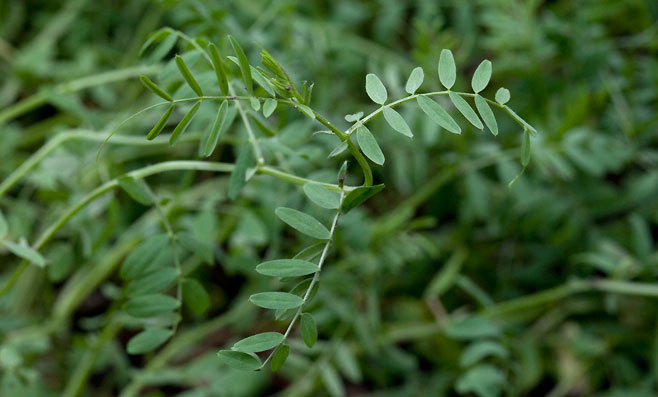Lens culinaris (Lentil) [= Lens esculenta] Life
> eukaryotes >
Archaeoplastida >
Chloroplastida
>
Charophyta > Streptophytina > Plantae (land plants)
> Tracheophyta (vascular plants) > Euphyllophyta > Lignophyta (woody plants)
> Spermatophyta (seed plants) > Angiospermae (flowering
plants) > Eudicotyledons > Core Eudicots > Rosids >
Eurosid I > Fabales > Family: Fabaceae > Subfamily: Papilionoideae
 |
|
Lens culinaris, Vienna Botanical Gardens,
Austria. [photo
H.G.
Robertson, Iziko ©] |
Originates from the Near East and central Asia. People were harvesting
wild lentils by 11200 years ago and by 8800 years ago they were being
cultivated.
Lens culinaris is native to the Near East and central Asia. The
wild subspecies Lens culinaris orientalis is found in Turkey, Syria,
Lebanon, Israel, Jordan, Iraq, Iran, Afghanistan and central Asia. Domestication
involved selecting for plants that retain their seeds in the pod so that they
are not lost before harvest, and selecting for greater seed size. Like many
domesticated food plants, L. culinaris is mainly self-pollinated which
means that it is easy to keep separate breeding lines.
The domestication of Lens culinaris formed an important part of the
agricultural revolution in the Neolithic, along with Wheat and Barley. Although
the amount harvested per unit area for Lentil is less than for Wheat and Barley,
the high protein content (25%) of Lentil seeds makes them a highly nutritious
(and tasty) food source. The same argument applies to peas and chickpeas which were also part
of the Neolithic agricultural scene. Small seeds of Lentil have been found in
archaeological excavations of pre-farming comunities in Syria dating from 9200
to 7500 BC. It is clear that at this time people were harvesting seeds of wild
Lentil, wild Barley and wild Einkorn Wheat. It is difficult to establish
when Lentil started being domesticated because the only way one can determine
evidence of domestication from seeds is an increase in seed size which happened
only gradually over a long period of time. However, there is clear evidence from
a large store of lentils found at an archaeological site in northern Israel that
by 6800 BC Lentil were being cultivated. Lentil seeds are also found
abundantly in later Neolithic sites.
Lentil is grown these days mainly in the region extending from the Atlantic
coast of Spain and Morocco in the west through to India in the east. From the
time of its domestication through till about 500 years ago, Lentil was more
important as a food to people than Pea but in the last few hundred years, peas
have become predominant.
References
-
Sauer, J.D. 1993. Historical geography of
crop plants - a select roster. CRC Press, Boca Raton, Florida.
-
Zohary, D. & Hopf, M. 1993. Domestication
of plants in the old World - The origin and spread of cultivated plants in
West Asia, Europe, and the Nile Valley. Clarendon Press, Oxford.
Text by Hamish Robertson |
